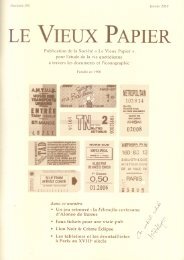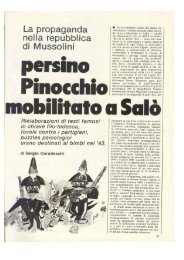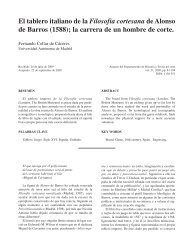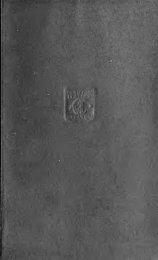Board games from the city of Vijayanagara (Hampi ... - Gioco dell'Oca.
Board games from the city of Vijayanagara (Hampi ... - Gioco dell'Oca.
Board games from the city of Vijayanagara (Hampi ... - Gioco dell'Oca.
You also want an ePaper? Increase the reach of your titles
YUMPU automatically turns print PDFs into web optimized ePapers that Google loves.
B OOK R EVIEWS / COMPTES RENDUS / REZENSIONEN 127<br />
Roberto CONVENEVOLE and Francesco BOTTONE,<br />
La storia di Risiko e l’anello mancante : origini e evoluzione del gioco di strategia più diffuso<br />
nel mondo. Roma : novecento, 2002. 191 p. ; large colour folder (4 maps) ; b/w map.<br />
ISBN 88-88423-09-5. Price: € 13.90.<br />
In Italy <strong>the</strong> board game “Risk” is called “Risiko!” thus using <strong>the</strong>… German name <strong>of</strong><br />
<strong>the</strong> game. (In Italian ‘risk’ is rischio.) This strange phenomenon has not prevented <strong>the</strong><br />
Italian players <strong>from</strong> acclaiming <strong>the</strong> strategic game and making it very successful in <strong>the</strong>ir<br />
country. This may explain why it is in Italy and in Italian that “Risk” has found its first<br />
historians.<br />
In La storia di Risiko e l’anello mancante (The story <strong>of</strong> Risk and <strong>the</strong> ‘Missing Link’ (1) :<br />
origins and evolution <strong>of</strong> <strong>the</strong> world’s most widespread strategic game) Roberto Convenevole<br />
and Francesco Bottone <strong>of</strong>fer more than pure history. They also present <strong>the</strong> structure<br />
<strong>of</strong> Risk, discussing <strong>the</strong> balance between luck and strategy, and <strong>the</strong> number <strong>of</strong> dice<br />
involved (5 or 6), <strong>the</strong>y list all Risk’s variants and versions, <strong>the</strong>n <strong>the</strong>y present <strong>the</strong>ir own<br />
variant, called “L’anello mancante” (here translated as <strong>the</strong> ‘Missed Link’) or “blind Risk”.<br />
The rules <strong>of</strong> “L’anello mancante” are printed in four languages: Italian, French, (2) English<br />
and German. The book ends with no less than five appendices, <strong>the</strong> first one giving reproductions<br />
<strong>of</strong> <strong>the</strong> original patents with <strong>the</strong>ir translations in Italian, followed by <strong>the</strong> ma<strong>the</strong>matics<br />
<strong>of</strong> Risk (Appendix 2), a presentation <strong>of</strong> Eric Solomon’s classification <strong>of</strong> board<br />
<strong>games</strong> and o<strong>the</strong>r considerations.<br />
The present reviewer has no authority for commenting upon “L’anello mancante” but<br />
is more interested in what Convenevole and Bottone have to say about <strong>the</strong> origin and<br />
history <strong>of</strong> “Risk” or, as it was first called by its inventor, French film-maker Albert<br />
Lamorisse, “La Conquête du Monde” (The Conquest <strong>of</strong> <strong>the</strong> World). They <strong>of</strong>fer an<br />
impressive insight in <strong>the</strong> early steps <strong>of</strong> <strong>the</strong> game, as it was designed and patented (in<br />
1954) by Albert Lamorisse (1922-1970), better known for his children’s films Crin Blanc<br />
(1952) and Le ballon rouge (1955) both prize-winners at Cannes. After a thorough<br />
description <strong>of</strong> this first patent Convenevole and Bottone deal with <strong>the</strong> first production<br />
<strong>of</strong> <strong>the</strong> game, which was done by France’s leading game-publishing company <strong>of</strong> <strong>the</strong> time,<br />
Miro Company (established in 1936, taken over in 1969 by US group General Mills<br />
<strong>the</strong>n merged into a larger company called Miro-Meccano in 1980, later renamed General<br />
Mills Jeux et Jouets <strong>the</strong>n sold in 1986 to Hasbro). Miro Company was <strong>the</strong>n flourishing<br />
and had close relationships both with Parker Bros. – it was <strong>the</strong> French publisher <strong>of</strong><br />
“Monopoly” since 1937 – and with Waddington in Britain.<br />
As it was “La Conquête du Monde” was very original but did not play well enough.<br />
This is why <strong>the</strong> Miro Company director wanted to improve Lamorisse’s game. For this<br />
he required <strong>the</strong> help <strong>of</strong> Jean-René Vernes (3) who had designed a game called “Rome et<br />
Carthage” (which Vernes had patented as early as 1951), which Miro had published in<br />
1954. The game was very successful and quite new in its principles. From 1955 to 1957<br />
Vernes worked with Lamorisse for improving <strong>the</strong> game, making it faster and shorter.<br />
We owe to Roberto Convenevole many details which he got directly <strong>from</strong> personal correspendence<br />
with Jean-René Vernes.







